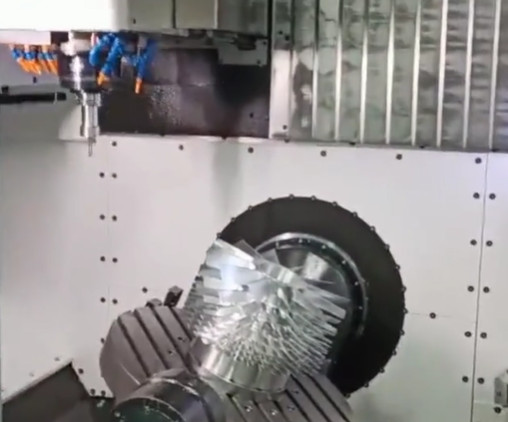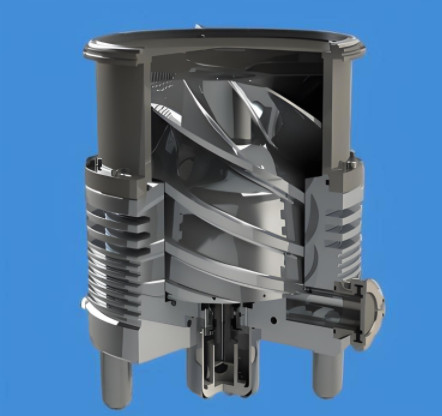Molecular pumps are critical components in semiconductor manufacturing, providing ultra-high vacuum environments essential for processes like etching, deposition, and lithography. The impeller, a core element of the molecular pump, requires exceptional machining precision to ensure performance, reliability, and compatibility with stringent semiconductor requirements. This guide outlines systematic approaches to optimize impeller machining precision, focusing on technical processes, equipment, materials, and quality control. The content is structured to provide actionable insights for engineers and manufacturers, emphasizing experience-based methods and detailed parameters.
Understanding Molecular Pump Impeller Requirements
The impeller in a molecular pump is a high-speed rotating component, typically operating at speeds exceeding 20,000 RPM, designed to transfer gas molecules through kinetic energy. Its geometry, balance, and surface finish directly impact pump efficiency, vibration levels, and vacuum integrity. For semiconductor applications, impellers must achieve tolerances as tight as ±0.005 mm for critical dimensions and surface roughness below Ra 0.4 µm to minimize gas turbulence and ensure stable operation.
Key requirements include:
- Dimensional Accuracy: Critical for maintaining gas flow dynamics and rotor-stator clearance, typically 0.01–0.02 mm.
- Dynamic Balance: Imbalance must be below G0.4 (ISO 1940 standard) to prevent vibrations at high speeds.
- Material Integrity: Aluminum alloys (e.g., 7075-T6) or titanium are common due to their strength-to-weight ratio and corrosion resistance.
- Surface Quality: Smooth surfaces reduce outgassing and particle generation, critical for cleanroom environments.
These requirements demand advanced machining techniques, precise tooling, and rigorous quality assurance, as outlined in subsequent sections.

Material Selection and Preparation
Material choice significantly affects machining precision and impeller performance. Aluminum alloy 7075-T6 is widely used due to its high strength (yield strength: 503 MPa), low density (2.81 g/cm³), and machinability. Titanium alloys, such as Ti-6Al-4V, are selected for applications requiring higher corrosion resistance or thermal stability, though they pose machining challenges due to lower thermal conductivity (6.7 W/m·K vs. 130 W/m·K for aluminum).
Preparation steps include:
- Material Inspection: Use ultrasonic testing to detect internal defects and ensure homogeneity. Surface inclusions must be absent to avoid machining inconsistencies.
- Stress Relief: Apply thermal stress relief (e.g., 120°C for 6 hours) to minimize residual stresses that could cause deformation during machining.
- Pre-Machining: Rough cut blanks to near-net shape using wire EDM or turning to reduce material removal in precision stages, minimizing tool wear and heat generation.
Proper preparation ensures consistent material behavior, reducing dimensional deviations during high-precision machining.
Advanced Machining Techniques
Precision machining of molecular pump impellers relies on multi-axis CNC systems, typically 5-axis milling machines, to achieve complex geometries like curved blades and tight tolerances. Key techniques include:
5-Axis CNC Milling
5-axis machines enable simultaneous control of tool orientation and workpiece position, allowing continuous tool contact with complex surfaces. Parameters include:
- Spindle Speed: 10,000–15,000 RPM for aluminum, 2,000–4,000 RPM for titanium.
- Feed Rate: 0.05–0.1 mm/tooth for finishing passes to minimize tool deflection.
- Tool Path Strategy: Use trochoidal milling for roughing to reduce cutting forces and adaptive clearing for finishing to maintain consistent chip load.
Tool selection is critical. Polycrystalline diamond (PCD) tools are preferred for aluminum due to their wear resistance, while coated carbide tools (e.g., TiAlN) suit titanium.
High-Speed Machining (HSM)
HSM reduces cutting forces and heat generation, preserving dimensional accuracy. Typical HSM parameters for impellers are:
- Cutting Speed: 300–500 m/min for aluminum, 50–80 m/min for titanium.
- Depth of Cut: 0.1–0.3 mm for finishing to avoid thermal distortion.
- Coolant: Use minimum quantity lubrication (MQL) with synthetic esters to reduce thermal expansion while maintaining cleanroom compatibility.

Electrochemical Machining (ECM)
For ultra-fine surface finishes, ECM can complement CNC milling by removing material through controlled anodic dissolution. ECM achieves surface roughness of Ra 0.1 µm without introducing mechanical stresses, ideal for final blade polishing.
Combining these techniques ensures impellers meet semiconductor-grade precision while maintaining structural integrity.
Tooling and Fixturing
Tooling and fixturing play a pivotal role in achieving machining precision. Improper setups can lead to vibration, tool deflection, or workpiece distortion.
Tooling Considerations:
- Tool Runout: Maintain runout below 0.002 mm using precision collets or hydraulic chucks.
- Tool Length: Minimize overhang (L/D ratio < 3) to reduce deflection, especially for small-diameter tools (e.g., Ø2 mm ball-end mills).
- Tool Inspection: Use laser-based tool setters to verify geometry and wear before each operation.
Fixturing Strategies:
- Vacuum Chucks: Ideal for thin-walled impellers to avoid clamping stresses. Ensure vacuum pressure is stable at 0.8 bar.
- Modular Fixtures: Use adjustable fixtures with datum pins for repeatable setups, reducing alignment errors to <0.01 mm.
- Vibration Damping: Incorporate damping pads or viscoelastic materials in fixtures to absorb high-frequency vibrations.
Regular maintenance of tooling and fixtures, including cleaning and recalibration, ensures consistent performance across production runs.
Quality Control and Inspection
Rigorous quality control is essential to verify impeller precision. Inspection methods must be non-destructive and capable of measuring micro-scale features.
Key Inspection Techniques:
| Method | Application | Accuracy | Parameters Measured |
|---|---|---|---|
| Coordinate Measuring Machine (CMM) | Dimensional verification | ±0.001 mm | Blade thickness, diameter, clearance |
| Optical Profilometry | Surface roughness | Ra 0.01 µm | Surface finish, micro-defects |
| Laser Scanning | 3D geometry mapping | ±0.005 mm | Blade curvature, overall shape |
Dynamic Balancing: Post-machining, impellers undergo balancing on dedicated machines (e.g., Schenck balancing systems) to achieve G0.4 grade. Residual unbalance is corrected by laser ablation or material addition.
Traceability: Implement a digital tracking system to log machining parameters, inspection results, and material certifications. This ensures compliance with semiconductor industry standards like ISO 9001 and SEMI S2.
Regular calibration of inspection equipment, using certified reference standards, maintains measurement reliability.
Process Optimization Parameters
Optimizing machining precision requires fine-tuning process parameters based on material, geometry, and equipment. The following table summarizes recommended parameters for aluminum 7075-T6 impellers:
| Process | Parameter | Value | Notes |
|---|---|---|---|
| 5-Axis Milling | Spindle Speed | 12,000 RPM | Adjust for tool diameter |
| 5-Axis Milling | Feed Rate | 0.08 mm/tooth | Finishing pass |
| HSM | Cutting Speed | 400 m/min | Reduce for complex geometries |
| ECM | Current Density | 20 A/cm² | For Ra 0.1 µm finish |
These parameters should be validated through test runs, with adjustments based on real-time monitoring of tool wear, surface quality, and dimensional accuracy.
Environmental and Operational Considerations
Machining precision is influenced by environmental and operational factors, particularly in cleanroom settings required for semiconductor equipment.
Temperature Control: Maintain workshop temperature at 20 ± 1°C to minimize thermal expansion. Use temperature-compensated CNC machines with linear encoders for positional accuracy.
Cleanroom Compatibility: Employ oil-free coolants and HEPA-filtered air systems to prevent particle contamination. Post-machining cleaning with isopropyl alcohol and ultrasonic baths ensures particle-free surfaces.
Operator Training: Train personnel in CNC programming, metrology, and cleanroom protocols to reduce human-induced errors. Regular skill assessments maintain process consistency.
These considerations ensure that machining aligns with the stringent requirements of semiconductor manufacturing environments.

Conclusion
Optimizing molecular pump impeller machining precision for semiconductor equipment demands a systematic approach, integrating advanced machining techniques, precise tooling, rigorous quality control, and environmental management. By selecting appropriate materials, fine-tuning process parameters, and leveraging high-accuracy inspection methods, manufacturers can achieve the tight tolerances and surface finishes required for ultra-high vacuum systems. This guide provides a technical foundation for engineers to enhance impeller performance, ensuring reliability and efficiency in semiconductor production.
